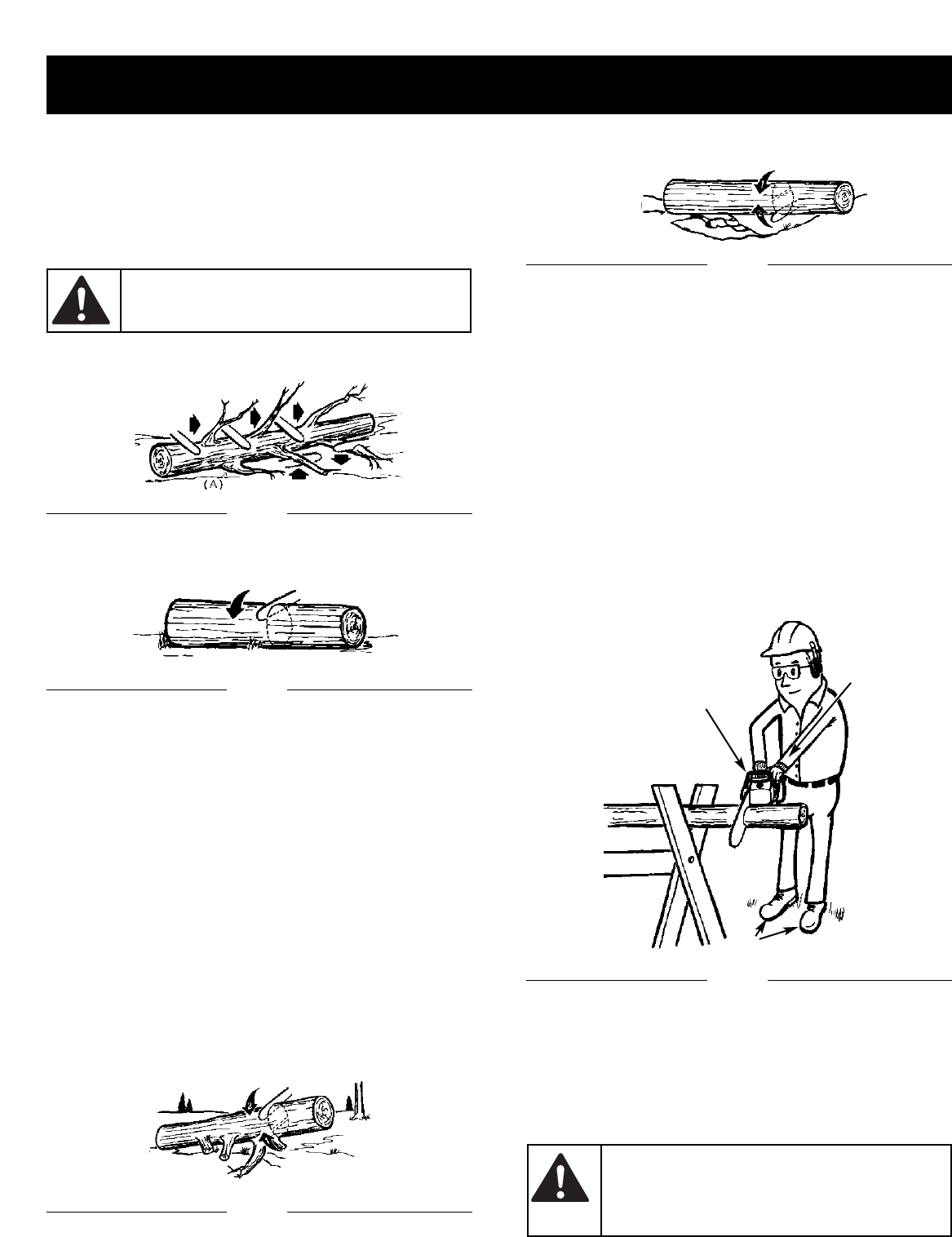
LIMBING
Limbing a tree is the process of removing the branches
from a fallen tree. Do not remove supporting limbs(A)until
after the log is bucked (cut) into lengths (Figure 21).
Branches under tension should be cut from the bottom up
to avoid binding the chain saw
.
BUCKING
Bucking is cutting a fallen log into lengths. Make sure you
have a good footing and stand uphill of the log when cut-
ting on sloping ground. If possible, the log should be sup-
ported so that the end to be cut off is not resting on the
ground. If the log is supported at both ends and you must
cut in the middle, make a downward cut halfway through
the log and then make the undercut. This will prevent the
log from pinching the bar and chain. Be careful that the
chain does not cut into the ground when bucking as this
causes rapid dulling of the chain.
When bucking on a slope, always stand on the uphill side.
1. Log supported along entire length: Cut from top (over-
buck), being careful to avoid cutting into the ground
(Figure 22).
2. Log supported on 1 end: First, cut from bottom (under-
buck) 1/3 diameter of log to avoid splintering. Second,
cut from above (overbuck) to meet first cut and avoid
pinching (Figure 23).
3. Log supported on both ends: First, overbuck 1/3 diame-
ter of log to avoid splintering. Second, underbuck to
meet first cut and avoid pinching (Figure24).
NOTE:
The best way to hold a log while bucking is to use
a sawhorse. When this is not possible, the log should be
raised and supported by the limb stumps or by using sup-
porting logs. Be sure the log being cut is securely support-
ed.
BUCKING USING A SAWHORSE
For personal safety and ease of cutting, the correct position
for vertical bucking is essential (Figure 25).
VERTICAL CUTTING:
A. Hold the saw firmly with both hands and keep the saw to
the right of your body while cutting.
B Keep the left arm as straight as possible.
C. Keep weight on both feet.
GENERAL CUTTING INSTRUCTIONS
Proper maintenance of the guide bar, as explained in
this section, is essential to keep your saw in good
working order.
GUIDE BAR MAINTENANCE :
Most guide bar problems can be prevented merely by
keeping the chain saw well maintained.
Incorrect filing and non-uniform cutter and depth gauge set-
tings cause most guide bar problems, primarily resulting in
uneven bar wear. As the bar wears unevenly, the rails
widen, which may cause chain clatter and difficulty in mak-
ing straight cuts.
Insufficient guide bar lubrication and operating the saw with
a chain that is TOO TIGHT will contribute to rapid bar wear
.
To help minimize bar wear, the following guide bar mainte-
nance is recommended.
BAR WEAR - Turn guide bar frequently at regular intervals
(for example, after 5 hours of use), to ensure even wear on
top and bottom of bar.
BAR GROOVES - Bar grooves (or rails which support and
carry the chain) should be cleaned if the saw has been
heavily used or if the saw chain appears dirty. Rails should
always be cleaned every time the saw chain is removed.
OIL PASSAGES - Oil passages at bar pad should be
cleaned to ensure proper lubrication of the bar and chain
during operation. This can be done using a soft wire small
enough to insert into the oil discharge hole.
To Clean Guide Bar Rails:
1.
Remove sprocket cover, bar and chain .
2.
Using a screwdriver, putty knife, wire brush or other sim-
ilar instrument, clear residue from the rails on the guide
bar.
This will keep the oil passages open to provide proper
lubrication to the bar and chain (Figure 26).
3. Reinstall the bar, chain and bar bolt retaining nuts. .
A low-kickback or “safety chain”, should never be regarded
as total protection against injury.A low-kickback saw chain
should always be used in conjunction with other kickback
protection devices such as the Hand Guard furnished with
your unit.
Always use a replacement saw chain designed as “low-
kickback” or a saw chain which meets the low-kickback
performance.
A standard saw chain (a chain which does not have the
kickback reducing guard links) should only be used by an
experienced professional chain saw operator.
What is a Low-Kickback Saw Chain?
A low-kickback saw chain is a chain which has met the
kickback performance requirements of ANSI B175.1. Do
not use other replacement chain unless it has met these
requirements for your specific model.
By keeping the saw chain in good working condition and
correctly serviced as recommended in this manual, you will
be able to maintain the safety system of your chain saw
over the life of the product.
MAINTENANCE INSTRUCTIONS
While the saw is cut-
ting, be sure the
chain and bar are being properly lubricated.
CAUTION:
B
A
C
Ensure that the
power cord is discon-
nected before per-
forming any maintenance on your saw.
WARNING:
GUIDE BAR MAINTENANCE
Fig.26
Unless you have experi-
ence and specialized
training for dealing with kickback (see Safety
Precautions), always use a low-kickback saw
chain, which significantly reduces the danger of
kickback. Low-kickback saw chain does not
completely eliminate kickback.
WARNING:
CHAIN MAINTENANCE INSTRUCTIONS
18
Never cut tree limbs
while standing on
tree trunk
WARNING:
Fig.21
Fig.22
Fig.23
Fig.24
Fig.25
17


















